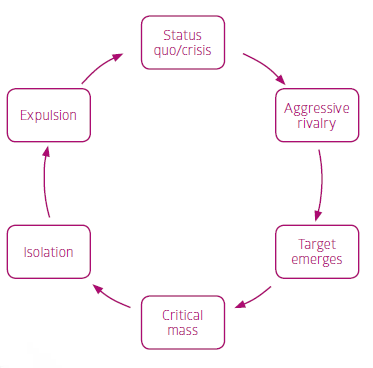The phenomenon of scapegoating is a systemic and global issue. Scapegoating systems are found in politics, judiciary systems, healthcare institutions, academia, the corporate workplace, families and schools. Most people are vaguely familiar with what scapegoating is as an act of displaced blame, but few really understand how it works as an ongoing cycle of violence that leaves its targets in conditions of extreme emotional, psychological and often physical distress. The effect of scapegoating on the target can culminate in maladies such as post-traumatic stress disorder or anxiety/depression. In many cases, targets give in to suicide.
I have witnessed two extreme cases of scapegoating in my home country, the United States. These cases were in very different contexts, but the lengthy process and stages of scapegoating were distinguishable and identical in both cases. So was the devastating effect on the targets. As a scholar, organisational trainer and consultant, but more so as a friend to the targets, I felt the need to research this crushing form of violence and bring awareness to it. Despite the tragic consequences of scapegoating, the phenomenon is not well understood in the US.
This article outlines why scapegoating happens,how it can manifest in the workplace, and some solutions for organisations looking to protect against it. While much of my research is based in the US, scapegoating is a human process that has been utilised across cultures for thousands of years. Thus my findings have relevance to health professionals engaged in supporting emotional and psychological health at work in the UK and elsewhere.
Certainly, in the US workplace, and possibly in Europe, scapegoating is typically lumped in with the notion of bullying, which is misleading and prevents people from locating the resources needed to address what is a different problem.1 To pinpoint just one particular danger in conflating scapegoating with bullying, research shows that the scapegoated, suffering target is commonly mislabelled a bully if they display any sign of anger or negative emotion.2 This creates further emotional distress for the target, also deflecting attention away from the real cause of the violence. Anti-bullying workplace policies can lamentably aid and abet a scapegoating in this way.3
‘Mobbing’ is another term often used to describe workplace abuse that may be misleading. First coined by Austrian zoologist Dr Konrad Lorenz in his book On Aggression,4 and later adopted by Dr Heinz Leymann, Swedish psychologist,5 the term ‘mobbing’ is sometimes used in Europe and Australia (and much less so in the US) to describe what looks something like ‘group’ or ‘organisational bullying’. Canadian sociologist Dr Kenneth Westhues has also written extensively on mobbing, specifically in academia.6
Lorenz originally used the term to describe the behaviour of birds. Certain species of birds will, literally, ‘put a hate on’ (from the German)7 or ‘mob’ a potentially dangerous predator in order to protect their offspring. Bird mobbing may also be a type of behaviour to assert dominance. Lorenz asserts that humans have the same mobbing instinct channelled through culture.
Human ‘mobbing’, however, is much slower and more complex than what birds do; it is also subtle and manipulative, often paired with a blaming aspect. Why humans ‘mob’ does not seem to be fully answered by Lorenz’ analysis, bringing the accuracy of the term ‘mobbing’ for human behaviour into question. Perhaps there is something much more insidious going on that is unique to human nature? While maintaining some of Lorenz’ observations, academician René Girard offers an alternative possibility. Girard, who shockingly distinguished scapegoating violence as the foundation of culture, in his book Violence and the Sacred, asserts that it is ultimately envy, or what he calls ‘mimetic desire’ that creates the rivalry that leads to scapegoating; and this is notably not animal instinct at all, but a uniquely human trait.8
Girard states that humans engage in such complex imitative rivalry that we must ultimately scapegoat in an effort to contain the violence that would otherwise be unleashed in a much greater form. This process mostly if not completely happens below our awareness, but the marks of ‘mimetic rivalry’ and scapegoating are clear once we learn their characteristics. What if one applied Girard’s analysis to workplace systems? Let us turn to this now.
Scapegoating as an alternative model of workplace abuse
Very simply, scapegoating entails undue blame being put on someone as the cause of a real or perceived crisis, such that the target becomes the centre of escalating hostile attention. The goal of scapegoating is the eventual expulsion of the target, whether by termination or forced resignation; in a scapegoating, the target is made out to be like a disease infecting the institution that needs to be purged.9
One of the telltale signs of a scapegoating is that there is no discernable conflict between the persecutors or persecuting organisation and the target that could be worked through towards resolution. Resolution is not the goal. The target is more like an institutional sacrifice, made with the romantic hope of relieving a community crisis.
There is nothing new about this phenomenon. Scapegoating has held a place in the human psyche for over three thousand years. In Leviticus of the Hebrew Bible, for example, all the sins of the community of Israel are placed on a goat (literally, a ‘scapegoat’), which is then sent off into the wilderness – banished from the community. This was how the ancient Israelites purged themselves of their sins on the Day of Atonement. Some say that Jesus was a scapegoat, blamed for the conflict between the diverse communities comprising Judea at the time of his ministry, and that the Gospels are meant to reveal to humanity this particular form of systemic violence.8
While humanity may know about scapegoating at an intellectual level, we seem vastly in the dark about how often we witness and even participate in it. The reality is that scapegoating occurs every day, on the global scene, in our national news, and in our lives. It also occurs in our workplaces. What is needed is a clear delineation of the phenomenon that can help us to identify it in each of its stages, especially if we find that we have become a target, or are in the position of supporting a target through this devastating process.
The vicious cycle of scapegoating
Scapegoating in the workplace happens in six stages. The entire cycle may develop very quickly (e.g. within six months) or very slowly over years. Each phase has specific characteristics that help one to identify what is happening, aiding in the attempt to manage the violence, and hopefully avert its most devastating effects.

Stage one: status quo/crisis
Stage one is the advent of a real or perceived workplace crisis that poses a threat to the status quo. There may be a change in management or the possibility of promotion or demotion. Perhaps the organisation is considering budget cuts. The threat to the status quo may be real, but fear (i.e. perceived crisis) can also be a trigger. For example, if a manager or team is given a project at which they think they might fail, their own imagined crisis may begin the cycle.
Stage two: aggressive rivalry
Stage two involves the development of aggressive rivalry between teams or individuals. The crisis of stage one creates an atmosphere of survival. This phase is one of increasing rivalry and ‘sameness’: whereas before, everyone was secure in their distinct role, now lines between roles are blurred. For example, people may be asked to pitch in on non-job-specific tasks. In this developing pressurised system, all mirror each other’s survival instinct.
Stage three: the target emerges
Stage three involves the emergence of the target. ‘Sameness’ creates unrest and confusion: people’s identities feel threatened; their work functions seem unclear; jobs feel unimportant or unnecessary. As rivalry among an entire workforce is inherently unsustainable, rivalry now shifts to blame an individual target. The process of dehumanising the target now begins, and violence takes root.
Stage four: critical mass
This phase has an all-against-one characteristic. People join with the dominant group and gain a feeling of power against the target; one may feel peer pressure to do so. There will be ‘bystander’ participation.
The target is now a ‘liminal’ figure set up for scapegoating. Liminal means to literally be ‘in between.’ The target is still working for the organisation, but is also being rejected by the organisation. The target has a job function, but their function is being manipulated. The target’s blurred identity aids their dehumanisation and makes them an acceptable receiver of blame and violence. The target now appears like a disease and a threat.
Stage five: isolation
The escalating dehumanisation of the target creates isolation and causes the target severe distress, often manifesting in health issues, poor work performance, and psychological issues. Misjudgment by management and colleagues reinforces the trauma on the target.
The target’s suffering and behaviour now ‘proves’ how the organisation has cast them. The target thus becomes branded as difficult, incompetent, or mentally ill.
The organisation continues to inflict destabilising influences upon the target, which may include withholding necessary information; uncommunicated shifting of goal posts; constant undervaluing of the target’s efforts; unreasonable refusal of applications for training or leave; etc.
Stage six: expulsion
Stage six is the expulsion of the target. The target leaves the organisation either voluntarily or by forced resignation or termination. The cumulative trauma can trigger or exacerbate PTSD. Financial pressures associated with the job loss also mount up. Emotional distress and illnesses often intensify, sometimes resulting in suicide.
The target has successfully been blamed for the crisis, and the organisation is left with a sense of relief – a return to health and order – that will continue until the scapegoating process restarts. In some cases, the violence continues even after the target is expelled. The organisation may denigrate the target to future employers or social networks to publicly affirm the expulsion and the organisation’s actions leading up to it.
The target, on the other hand, is typically left traumatised and isolated – professionally and emotionally; with depleted finances and the inability to find new work. It is extremely difficult to understand the experience of the target, no matter how close one is to the person or how empathetic one is. Even the target can have difficulty comprehending what has happened, for the false reality that the persecuting organisation generates compels a deep insecurity about the target’s own understanding of events. Dr Janice Harper, who has written about her personal experience of being targeted, says: ‘I was living proof that cruel people could reduce a healthy person to a puddle of fear and emotion, and could and would destroy families and lives.’2 Yet this cruelty seems to remain unrecognised by those committing the violence and by the organisation at large.
Scapegoating requires delusion
After reading about the devastations and obvious cruelty of the scapegoating mechanism, one might wonder how it is that humans (indeed, we) are still able to participate in it. Even if we admit to the efficacy of scapegoating to alleviate a challenging situation and to bolster in-group morale, how can we live with the fact that we, at least indirectly, are creating sacrificial victims?
One possible answer is willing denial, even delusion. Scapegoating, because it seeks blame and expulsion as a remedy over a real addressing of the issues, in fact requires a level of delusion in order to be effective. Though deliberate scapegoating can and does occur, most of the people who become convinced of the target’s guilt do not do so out of facts presented, but due to groupthink, or the opinion of the masses that snowballs against the target. As the workplace crisis looms on, individual vulnerability heightens. Blaming a target becomes a blessed relief to the vulnerability that is, for most humans, unwanted and unbearable. It is an understandable delusion to participate in if one’s workplace culture reinforces the blame, too, especially if one wishes to avoid becoming the target oneself. But there are ways to choose otherwise, and for organisations to undermine efforts at scapegoating.
Solutions
Scapegoating workplaces require culture change at their core, and so there are no quick or easy solutions. The ultimate goal of eradicating a violent organisational culture is indeed the primary reason for adapting Girard’s theory of mimesis and scapegoating to the workplace. Identifying crisis, envy and sameness as essential factors in scapegoating enables appropriate transformative tools to be developed. An important step to begin this lengthy process, however, is to implement some protections for employees.
Protections might include: policies on workplace targeting (ensure the policies are worded in a way that will address the specific dynamics of scapegoating); a very clear, written outline of fair investigations practice, incorporating an external ‘non-invested’ group for checks and balances; and a recruitment process that includes some focus on character and relational skills. A programme focused on employee health is also strongly recommended.
Practices aimed at transforming the culture, such as educational efforts, are also crucial, and can be immediately implemented (though they may find some resistance). Seminars, trainings, an informal series of lunch discussions, are all straightforward ways to raise awareness of what scapegoating is and how it manifests in the workplace. Another particularly useful transformational practice is to create an ‘intervention team’. There is always safety in numbers. Create and train a team of ‘allies’ dedicated to eradicating scapegoating violence, and to acting as a sounding board for those who need assistance. Some groundwork to establish safety and trust in the organisation is required before any deeper work can begin.
Certainly the work that goes into transforming a sacrificial culture into a safe, trusting and transparent culture is a long and challenging process. It is much easier to just keep creating victims to blame. However, it is estimated that as many as twenty million people may be the targets of workplace abuse in the US each day,10 costing individuals and their families unprecedented health and financial issues, and costing organisations morale, productivity, and significant time and resources. It seems likely there will be at least this many additional instances around the globe. Now is the time to bring awareness and an end to this deleterious sacrificial system that has rightly been called ‘a workplace epidemic.’11
Vanessa Avery is a Religious Studies PhD and organisational consultant. Her research focuses on the cultivation of diversity and non-violence in organisational culture and scriptural interpretation. She is the author of several articles and a forthcoming book, The End of Violence, with Michigan State University Press.
More from Counselling at Work

Horses at work
Free article: Businesses are turning to equine-guided learning to seek out new professional development opportunities for their employees. Suzanne Slade explains why. Counselling at Work, Winter 2015

Sex offenders, pornography and the workplace
Open article: How would you work with a sex offender in a workplace setting? Juliet Grayson, Chair of (StopSO), challenges some misconceptions and offers advice. Counselling at Work, Autumn 2015

Cyberwork: Cyberslacking - internet use policies at work
Open article: In her regular column Kate Anthony says internet use policies protect both the employee and the employer. Counselling at Work, Summer 2015
References
1 While there have been a number of works written to distinguish the two phenomena (ie labelled ‘bullying ‘ and ‘mobbing ‘), there is still a push to consider them together due to the similar effects each has on the target. Chappell D, Di Martino V. Violence at work. Third edition. Geneva: International Labour Office; 2006. [Online.] www.ilo.org (accessed 25 February 2016).
2 Harper J. Mobbed! A survival guide to adult bullying and mobbing. Kindle edition; 2013. Available from Amazon Digital Services, LLC. Also Westhues K. Thirty two academic mobbing cases 2005-2008. August 2009, updated 2010. [Online.] www.kwesthues.com/ mobnews06.htm#USF (accessed 25 February 2016).
3 Workplace policies are not the only challenges here. State anti-bullying laws already established in US schools as well as proposed anti-bullying in the workplace bills (aka healthy workplace) can also cause unintended harm.
4 Lorenz K. Wilson MK (trans). On aggression. London, NY; Viking; 1966, 2002.
5 Leymann H. Mobbing and psychological terror at workplaces. Violence and Victims 1990; 5: 119–126.
6 Westhues K. Eliminating professors: a guide to the dismissal process. Edwin Mellen Press; 1998.
7 Westhues K. Mobbing, a natural fact. Adapted from the Graz paper delivered at the University of Graz, Austria; 2007 [Online.] www.kwesthues.com (accessed 25 February 2016).
8 Girard R, Gregory P (trans). Violence and the sacred. Maryland: Johns Hopkins University Press; 1979.
9 While Westhues makes a similar point in the context of mobbing, it seems important to understand the particular human mechanism behind the human need to expel, which the mobbing model does not provide. See also Dyckman J, Cutler J. Scapegoating at work: taking the bull’s-eye off your back. CT, London: Praeger; 2003.
10 Hornstein H. Brutal bosses and their prey. How to identify and overcome abuse in the workplace. New York: Riverhead Books; 1996.
11 Dr. Carroll Brodsky quoted in Davenport N, Distler Schwartz R, Pursell Elliott G. Mobbing: emotional abuse in the American workplace. Iowa: Civil Society Publishing; 2005.
